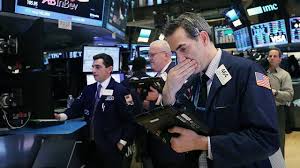Dow snaps longest losing streak in a year

The Dow barely snapped its longest slump in more than a year.
The average gained 60 points on Wednesday after a five-day losing streak. The S&P 500 inched higher, but the Nasdaq closed lower for the fifth straight day — its longest skid since November 2016.
Boeing(BA), the best-performing company on the Dow this year, helped the market get back on track. An optimistic forecast lifted Boeing’s shares 4%.
Investors hoped corporate earnings season would provide a respite to a fragile market. The Dow has been fighting to claw its way back from correction territory — down 10% since its record high in late January.
Earnings have been strong: 83% of companies to report on the S&P 500 so far have beaten Wall Street’s profit expectations. If that number holds, it would be a record, according to John Butters, senior earnings analyst at FactSet. Around 30% of companies have reported.
But their results have failed to live up to investors’ high expectations, which were raised by corporate tax cuts.
Investors feel “it’s not going to get any better” than right now, said Ed Yardeni, president of Yardeni Research.
Related: Boeing earnings are good and getting better
But several forces have caused a “re-balancing of the market” in recent weeks, said Quincy Krosby, chief market strategist at Prudential Financial.
Rising bond yields are putting pressure on stocks. The yield on the 10-year US Treasury note breached 3% for the first time in more than four years Tuesday. Inflation fears have contributed to the run-up in yields. Inflation eats away at the value of fixed bond payments, leading investors to demand a higher yield in return.
Car loans and mortgage prices are linked to the 10-year note, and rising yields will raise borrowing costs for companies and consumers. Investors worry that will slow consumer spending, the backbone of the economy.
Related: Hedge fund manager Kyle Bass: ‘There’s been a trade war with China since 2001’
Higher bond yields could also become more attractive than volatile stocks for many investors.
The 10-year yield inched up to 3.01% on Wednesday. If the yield marches to 3.05%, it could spark a new wave of selling, Krosby predicted.
“The uncertainty of what will happen next in the bond market is weighing on stocks,” Yardeni said.
Higher commodity costs have also jolted investors. Raising production costs could dent profit margins and force companies to take up the price of goods on consumers.
On Tuesday, Caterpillar (CAT), an industrial bellwether, warned on its earnings call that margins wouldn’t get any higher and the last three months were its “high-water mark” for the year. Caterpillar lost 6% on Tuesday and sent a chill across the market. A 425-point rout on Tuesday pushed the index back into negative territory for the year.
Oil prices have jumped toward $ 70 a barrel in recent weeks on geopolitical tensions in Syria and Iran. OPEC’s production cuts have mopped up a global oil glut that caused prices to crash to $ 26 a barrel in 2016.
The combination of higher yields and oil prices have heightened expectations of inflation — and tightening from the Federal Reserve. When inflation rises, that raises the possibility the Federal Reserve will hike interest rates at a faster pace to prevent the economy from getting too hot. The Fed is on track to raise rates for the second time this year in June.
Another alarming sign for investors: the US dollar is at a four-month high. A weak dollar has raised the value of exports for multinational companies, but it has rallied as yields climb.
